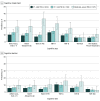Profiles of Cognitive Functioning at 6 Months After Traumatic Brain Injury Among Patients in Level I Trauma Centers: A TRACK-TBI Study
- PMID: 38147333
- PMCID: PMC10751593
- DOI: 10.1001/jamanetworkopen.2023.49118
Profiles of Cognitive Functioning at 6 Months After Traumatic Brain Injury Among Patients in Level I Trauma Centers: A TRACK-TBI Study
Abstract
Importance: Cognitive dysfunction is common after traumatic brain injury (TBI), with a well-established dose-response relationship between TBI severity and likelihood or magnitude of persistent cognitive impairment. However, patterns of cognitive dysfunction in the long-term (eg, 6-month) recovery period are less well known.
Objective: To characterize the prevalence of cognitive dysfunction within and across cognitive domains (processing speed, memory, and executive functioning) 6 months after injury in patients with TBI seen at level I trauma centers.
Design, setting, and participants: This prospective longitudinal cohort study used data from Transforming Research and Clinical Knowledge in TBI (TRACK-TBI) and included patients aged 17 years or older presenting at 18 US level I trauma center emergency departments or inpatient units within 24 hours of head injury, control individuals with orthopedic injury recruited from the same centers, and uninjured friend and family controls. Participants were enrolled between March 2, 2014, and July 27, 2018. Data were analyzed from March 5, 2020, through October 3, 2023.
Exposures: Traumatic brain injury (Glasgow Coma Scale score of 3-15) or orthopedic injury.
Main outcomes and measures: Performance on standard neuropsychological tests, including premorbid cognitive ability (National Institutes of Health Toolbox Picture Vocabulary Test), verbal memory (Rey Auditory Verbal Learning Test), processing speed (Wechsler Adult Intelligence Scale [4th edition] Processing Speed Index), and executive functioning (Trail Making Test).
Results: The sample included 1057 persons with TBI (mean [SD] age, 39.3 [16.4] years; 705 [67%] male) and 327 controls without TBI (mean [SD] age, 38.4 [15.1] years; 222 [68%] male). Most persons with TBI demonstrated performance within 1.5 SDs or better of the control group (49.3% [95% CI, 39.5%-59.2%] to 67.5% [95% CI, 63.7%-71.2%] showed no evidence of impairment). Similarly, 64.4% (95% CI, 54.5%-73.4%) to 78.8% (95% CI, 75.4%-81.9%) of participants demonstrated no evidence of cognitive decline (defined as performance within 1.5 SDs of estimated premorbid ability). For individuals with evidence of either cognitive impairment or decline, diverse profiles of impairment across memory, speed, and executive functioning domains were observed (ie, the prevalence was >0 in each of the 7 combinations of impairment across these 3 cognitive domains for most TBI subgroups).
Conclusions and relevance: In this cohort study of patients seen at level I trauma centers 6 months after TBI, many patients with TBI demonstrated no cognitive impairment. Impairment was more prevalent in persons with more severe TBI and manifested in variable ways across individuals. The findings may guide future research and treatment recommendations.
Conflict of interest statement
Figures


References
-
- Injury GBDTB, Spinal Cord Injury C; GBD 2016 Traumatic Brain Injury and Spinal Cord Injury Collaborators . Global, regional, and national burden of traumatic brain injury and spinal cord injury, 1990-2016: a systematic analysis for the Global Burden of Disease Study 2016. Lancet Neurol. 2019;18(1):56-87. doi:10.1016/S1474-4422(18)30415-0 - DOI - PMC - PubMed
Publication types
MeSH terms
Grants and funding
LinkOut - more resources
Full Text Sources
Medical

